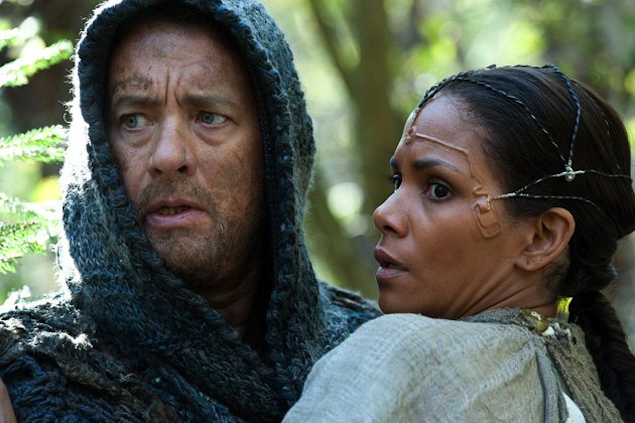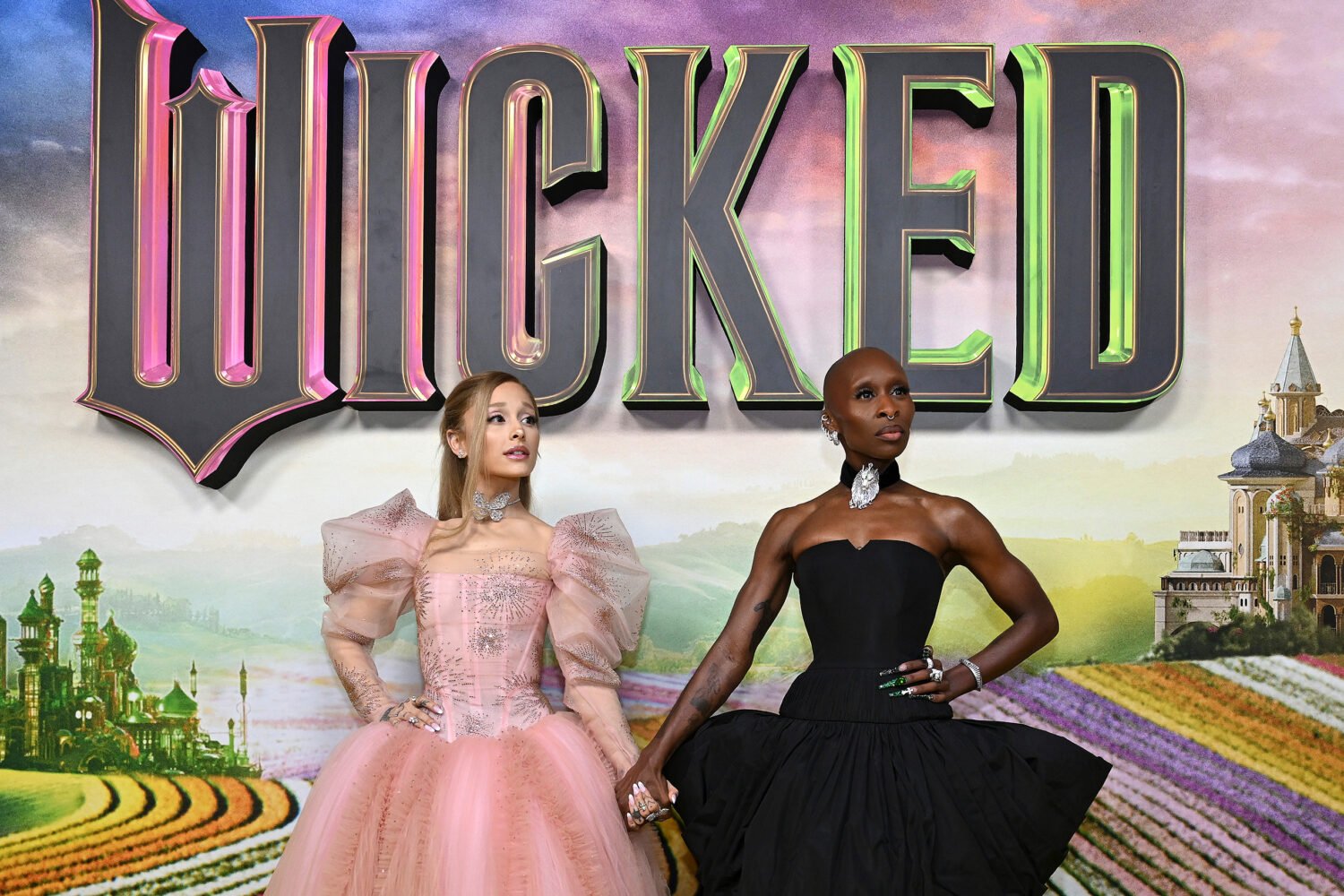If you could grade a film for effort,
Cloud Atlas would get an A+. Adapted from the “unfilmable” novel by David Mitchell, it runs nearly
three hours, through six interlocking stories made by three directors (The Matrix series’ Wachowski siblings and
Run Lola Run director Tom Tykwer). Those stories run span more than half a millenia, from the
mid-19th century through an indeterminate post-apocalyptic future. The same actors
are cast in different (often parallel) roles in each segment, and there is nothing
linear here, with frequent cross-cutting between segments to help define their relationships.
This is a staggeringly complex project, and the effort to assemble it is difficult
to imagine.
Unfortunately, effort isn’t all that counts, and the problems with
Cloud Atlas are many and insurmountable. While it’s no exaggeration to say this is the best film
the Wachowskis have directed since the first
Matrix film, that’s an extremely low bar. And sadly, the high school journal philosophizing
that made the
Matrix sequels so unbearable is ever-present here, often in wispy Terrence Malick-like voiceovers
that are as trite as they are tedious. Many of these stories, even with the lengthy
running time, feel too lightly sketched for the epic import they’re given. There simply
isn’t enough time to cover them sufficiently, and so only the lightest fare (a present-day
comedic plot in which Jim Broadbent’s character escapes from a locked-down retirement
community) works; the heaviest segments simply drag. As a result, the film feels every
bit as dauntingly long as its running time suggests, and getting through it can be
a test of both endurance and patience.
It’s not all bad. The cross-cutting between different timelines during tense moments
is done masterfully, so well that at times I thought the movie might even be saved
from itself. And all the performers here display skillful ranges, playing entirely
different characters within the same movie, even if they’re often betrayed by distractingly
poor makeup jobs, particularly when someone is made up to look like a different race.
(At my screening, the makeup produced unintended laughter in the theater on multiple
occasions.) All of this comes in a gorgeously shot package that blends the past, present,
and future into diverse, lushly imagined realities that at least manage the task of
feeling like they’re from a single work. If only that work actually succeeded in fulfilling
its lofty aspirations.
View the
trailer. Opens tomorrow in
theaters
all over the area.
Another film opens this week on a wave of hype, this one much smaller in scale. That’s
The Sessions, which won the Audience Award and the Special Jury Prize for Ensemble Acting earlier
this year at the Sundance Film Festival. John Hawkes stars as a polio sufferer who’s
paralyzed from the neck down and, at the age of 39, employs a sex surrogate in order
to lose his virginity. Helen Hunt plays the surrogate, while William H. Macy plays
the priest who gives him God’s blessing to make an exception to the no-premarital-sex
rule.
View the trailer. Opens tomorrow at E
Street and Bethesda Row.
Danish director Nicholas Winding Refn broke through in the US last year with the sparse
neo-noir of
Drive, but the director’s star rose faster and brighter in Europe, where his very first
film, 1996’s
Pusher, became a huge hit, though it was mostly a cult attraction over here. Refn directed
two sequels, and the film already inspired a 2010 Hindi remake. The British are taking
their turn now, and a limited release of director Luis Prieto’s take on the material
opens this week in DC. The film centers on a London drug dealer who finds himself
in an ever-deepening spiral of violence and isolation over the course of a single
week.
View the trailer. Opens tomorrow at West
End Cinema.
The Mark of Zorro with Hesperus
One of the very earliest examples of the classic silent film swashbuckler was this
1920 film starring Douglas Fairbanks. Zorro is a familiar figure now, but this was
the first film to feature the masked hero, just a year after author Johnston McCulley
created him for a serialized magazine story. The film tells the story of Zorro’s origin
as the son of a wealthy rancher who takes on the plight of the poor and downtrodden
against landowners like his father and a corrupt government that is complicit in their
mistreatment. The American Art Museum’s screening will be accompanied by a live soundtrack
from Hesperus, a musical group specializing in silent film performances.
View a scene from the movie. Sunday at
2 PM at the Smithsonian American Art Museum.
There are plenty of scary movie options in the coming
week, many of which are occuring
as part of the AFI’s annual series, which we covered last
week,
as well as new releases like
Paranormal Activity 4 and
Sinister. Washington Psychotronic Film Society gets in on the act, too,
with a screening of the 1991 low-budget schlocky horror-comedy film
HauntedWeen. The film centers on a fraternity haunted house fundraiser that becomes all too scary
when the students start being murdered for real.
View a clip from the movie. Monday at
8 PM at McFadden’s. WPFS screenings are free, but a $5
donation is suggested.
Blu-ray/DVD Pick of the Week:
Fear and Desire
Stanley Kubrick’s first feature, which he himself
wasn’t too fond of, existed more
in legend than in reality for most of the director’s life,
deliberately suppressed
from further distribution after initial release and later from
any sort of home video
release because it didn’t live up to the exacting, obsessive
standards he eventually
became known for. The only time I’d ever seen it was on a
blurry, scratchy VHS bootleg
years ago, which is probably even less the way Kubrick would
have liked for it to
be seen. It was only very occasionally seen at festival or
museum retrospectives via
the few privately held prints that existed. But the film was
recently fully restored
for Library of Congress preservation, and judging from the
Blu-ray
stills,
this looks nothing like the
Fear and Desire the handful of people who’ve seen it are used to.
It feels like a low-budget version of the standard Hollywood war movie of the day,
about a small group of soldiers stranded behind enemy lines and their attempts to
get back to their side. The catch is that Kubrick never identifies the countries that
are fighting—this is meant to be war in the abstract, a fact underlined in an ending
that gives the film a slightly surrealist feel. Much like his more well-known 1957
masterpiece,
Paths of Glory, this is a staunchly anti-war film, meant to show the inhumanity inherent in war.
Special Features:
The Seafarers, an industrial short made by Kubrick for the
Seafarers International Union the same year as
Fear and Desire. This was the first film Kubrick shot in color.
















